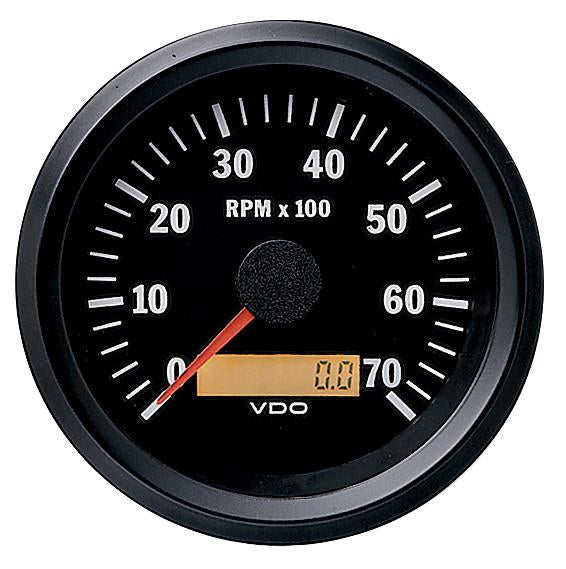Discovering the Functions and Advantages of a Tachometer: A Comprehensive Overview for Auto Fanatics
From supplying real-time data on engine speed to helping in optimizing gear changes, the tachometer serves as even more than simply a dial on the control panel. Its complex functions not only enhance driving experience however also play an essential function in maintaining engine health and efficiency.
Comprehending the Fundamentals of a Tachometer
In the world of auto instrumentation, comprehending the fundamentals of a tachometer is necessary for any type of automobile lover looking to dig into the details of engine efficiency monitoring. A tachometer, commonly shown on the control panel of a lorry, determines the engine's transformations per minute (RPM)
Tachometers typically have actually a range noted in changes per minute, with a redline showing the maximum rate at which the engine can securely run (tachometer). This info is vital for protecting against engine damage and optimizing equipment moving for hand-operated transmissions. In addition, tachometers can assist in detecting engine issues such as misfires or a stopping working ignition system by discovering irregular RPM analyses
Importance of Monitoring Engine Rate

Checking engine speed is an important facet of automobile upkeep and performance optimization for vehicle lovers and specialists alike. The engine speed, measured in changes per min (RPM), indicates just how quick the engine's crankshaft is rotating. By keeping a close eye on the RPM, vehicle drivers can make certain that the engine is running within the ideal variety, protecting against prospective damage from over-revving or stalling. Keeping track of engine speed is particularly important during equipment shifts, as it helps chauffeurs establish the correct time to alter equipments for smooth velocity and effective fuel consumption.
Furthermore, tracking engine rate can additionally give important insights right into the total health and wellness of the car. Uncommon fluctuations in RPM may indicate concerns such as a clogged up air filter, gas system issues, or also engine misfires. By spotting these abnormalities early on via the tachometer analyses, vehicle drivers can resolve potential concerns without delay, stopping extra severe damage and costly repair services down the line. Overall, keeping track of engine speed with a tachometer is a basic practice that can boost driving efficiency, extend engine life, and make sure a much safer and much more satisfying driving experience.
Enhancing Efficiency Via Equipment Shifts
Optimizing efficiency with critical gear shifts is a key aspect of optimizing a vehicle's efficiency and power result. Appropriate equipment moving makes certain that the engine operates recommended you read within its ideal power band, permitting smooth acceleration and improved gas economy. When shifting gears, it is important to focus on the engine rate indicated on the tachometer. By keeping track of the engine revolutions per minute (RPM), chauffeurs can figure out one of the most appropriate minutes to upshift or downshift for optimum efficiency.

To accomplish peak performance via equipment shifts, chauffeurs ought to exercise smooth and prompt transitions in between gears, matching engine speed with roadway speed to harness the full possibility of their vehicle's powertrain.
Making Best Use Of Effectiveness With a Tachometer
Grasping the art of gear shifting in high-performance automobiles not only improves driving experience however also plays a critical role in taking full advantage of efficiency with a tachometer. tachometer. By paying very close attention to the tachometer readings, chauffeurs can optimize their gear shifts to operate within the engine's most reliable variety. When speeding up, moving equipments at the appropriate RPM suggested by the tachometer can protect against the engine from exhausting or underperforming, leading to boosted fuel effectiveness and overall performance
Additionally, a tachometer aids drivers prevent unnecessary revving, which not only wastes fuel yet additionally places unnecessary pressure on the engine. Constantly monitoring the tachometer while driving permits smoother equipment changes, lowering wear and tear on Clicking Here the transmission system gradually.

Advanced Tips for Tachometer Usage
To dive into sophisticated ideas for tachometer utilization, think about integrating the use of shift lights. Shift lights are aesthetic indicators that illuminate when it's time to change gears based on engine transformations per min (RPM), enabling for smooth equipment adjustments without continuously keeping track of the tachometer. By fine-tuning shift factors and establishing advising thresholds, chauffeurs can enhance velocity and engine performance while decreasing the danger of over-revving.
Verdict
To conclude, the tachometer functions as a critical device for auto lovers to check engine speed, improve efficiency with equipment shifts, and take full advantage of published here performance. By comprehending the features and advantages of a tachometer, vehicle drivers can optimize their driving experience and lengthen the lifespan of their lorry. Utilizing sophisticated pointers for tachometer use can additionally enhance driving abilities and overall performance when driving.
 Ashley Johnson Then & Now!
Ashley Johnson Then & Now! Erik von Detten Then & Now!
Erik von Detten Then & Now! Burke Ramsey Then & Now!
Burke Ramsey Then & Now! Nancy Kerrigan Then & Now!
Nancy Kerrigan Then & Now! Richard Thomas Then & Now!
Richard Thomas Then & Now!